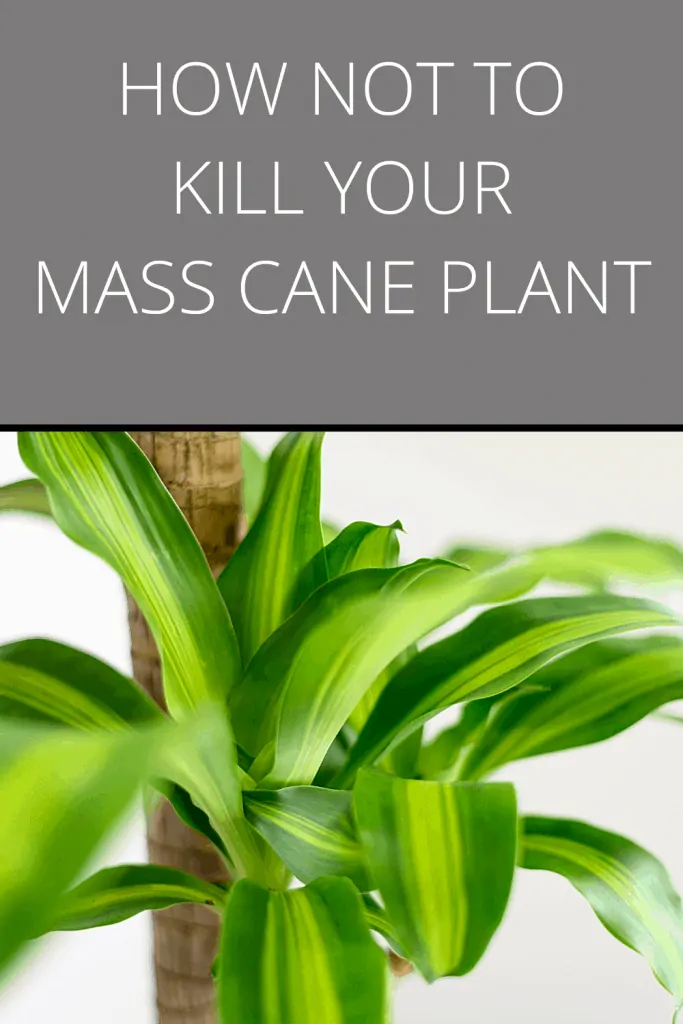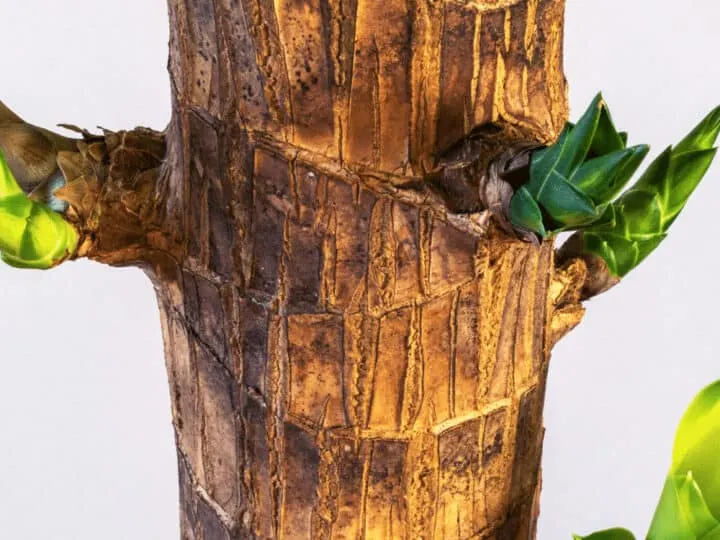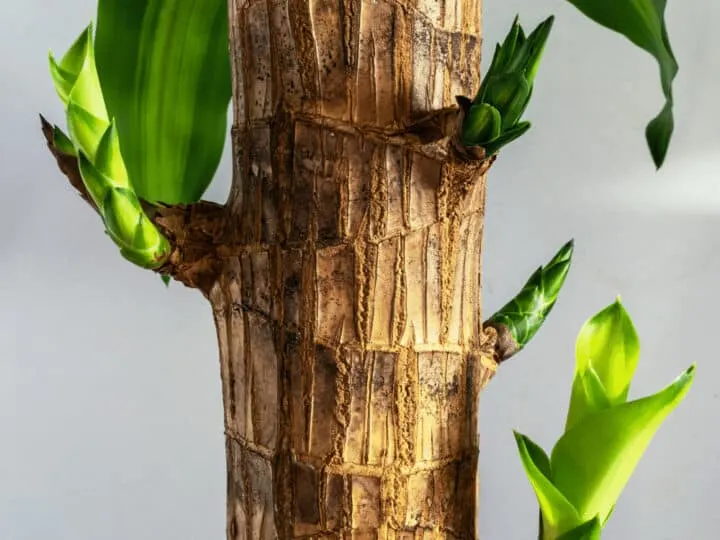The Mass Cane plant, or Dracaena fragrans, is a unique plant to own.
You may also have heard them referred to as the Corn plant.
Both of these names are chosen due to their morphology.
This plant has treelike “canes” or branches that shoot upwards. At the top are tropical leaves that have green and yellow streaks.
Native to parts of West Africa, Zambia, and Tanzania, the Mass Cane plant exists in tropical forests with relatively high humidity.
They are quite tolerant regarding growing indoors, making them an excellent addition!
This article will have everything you need to keep this exotic plant happy!
I also suggest you look at our general Dracaena plant care article highlighting different varieties.
Mass Cane Plant Care
To care for a Mass Cane plant, provide rich, well-draining potting soil and bright indirect light. Water once the soil becomes dry to the touch and provides a temperature between 64-75°F (18-24°C). 40-50% humidity is sufficient. Fertilize once a month in the growing seasons with a liquid fertilizer of NPK 5-5-5 or 10-10-10 at 1/2 strength.

Table of Contents
How to Care For a Mass Cane Plant
When you compare the Corn plant to other houseplants, you’ll be relieved that it is a great option for beginners.
This African plant isn’t all that picky regarding overall maintenance.

Mass Cane Plant Care
Mass Cane Soil
A Mass Cane Plant needs well-draining potting soil rich in nutrients.
Most plants are picky about the soil type, pH levels, and nutrients.
Dracaena fragrans are simple in this regard.
They will tolerate just about any soil as long as it has good drainage ports on the bottom of the pot.
Africa is known for having some of the richest soil, but it does depend on the region.
Although it isn’t necessary, you can try to recreate this and choose potting mix high in nutrients, such as clay.
Mass Cane Light Requirements
Indirect, bright light is the best for a Mass Cane plant.
Like their overall soil preferences, the Corn plant can be subjected to several lighting conditions.
This makes choosing a spot within your house very easy!
Some botanists have argued that when given in large doses, direct sunlight can be too much for the leaves.
If you have to put them in an area with low light, don’t fret! This will be more than adequate.
Remember that more light will equate to quicker, more vibrant growth. Just don’t allow the leaves to become scorched with too much sunlight.
Mass Cane Watering
Water a Mass Cane plant once the soil becomes dry to the touch, and soak the soil when watering. The amount of water you give your Dracaena fragrans should depend on the present sunlight.
Plants in bright lighting conditions will need more water since most of it has evaporated. Checking the soil is the best way to go.
The overall goal is for the soil to be anywhere from slightly dry to slightly saturated. Extremes don’t bode well for the Mass Cane plant.
Doing a simple soil check with your finger can be a great way to pinpoint the correct watering regimen. One thing to remember is that this flora is rather slow to show any signs of disturbance.
For instance, it will take weeks to see if you’ve added too much water.
Most plant enthusiasts agree that watering every week is the best time.
Temperature
The optimal temperature for a Mass Cane plant is between 64-75°F (18-24°C).
The typical conditions of West Africa and the areas surrounding this region are lots of sunshine and a warm climate.
Usually, this combination remains consistent throughout the year.
For this reason, the Corn plant prefers to be kept in a home with warmer temperatures.
They can handle temperatures that are higher than this. What they don’t do well with, however, is when the room dips below 12 degrees Celsius. This is when you’ll see damage to the leaves.
A quick fix to this problem is to close all windows whenever it is too cold.
Dracaena Fragrands grows outside in USDA hardiness zones 10b-11, according to the University of Florida.
Humidity
A Mass Cane plant does well in humidity, around 40-50%.
Being tropical, the Corn plant is used to handle high humidity levels.
This might make you assume these floras should be in a humid home.
Fortunately, this isn’t the case! On the contrary, they’ll be just fine with the moisture content found in most homes. This is at about 40 percent.
The only real harm is when your home’s humidity is below average.
If this happens, you’ll notice the leaves start to take on a brown coloration.

Fertilizer
Fertilize a Mass Cane plant using a liquid fertilizer at half strength during the growing season in spring and summer.
A balanced fertilizer with an NPK of 5-5-5 or 10-10.-10 works best.
Refrain from fertilizing in autumn or winter.
If you decide to fertilize in the non-growing season in autumn and winter, only fertilize every 2-3 months.
Propagation
Propagate a Mass Cane plant using shoots or stem (cane) cuttings.
Plant propagation can be a scary process. Even if you’re new to flora propagation, the Mass Cane plant can be straightforward and stress-free.
They produce shoots or new growth, easily grown into the parent plant.
The two most widely accepted methods of propagation are cane cuttings and division.
Both aren’t all that tricky. We will be providing steps for cane-cutting propagation later on in the article!
Related: Mass cane propagation
Growth
When given plenty of space to grow, they can reach a height of 15 feet (4.6 meters).
These plants are members of the genus Dracaena, a flowering species of succulent shrubs and trees.
Don’t worry. This wouldn’t happen in your home.
There are quite a few different varieties of the Mass Cane plant, making it easier for you to predict what the end height will be.
Depending on your choice, you’ll end up with someone anywhere from 2, 3, or 4 feet tall (0.6,0.9, 1.2m).
They are typically about 3 inches in width (7.6cm).
Potting
On the other hand, the Mass Cane plant should be repotted at least once a year.
With such a large mass, it doesn’t take long for the roots to become cramped.
Smaller houseplants generally require to be transferred every few years.
This will promote healthy growth. When you go about doing this, be mindful of the roots.
They aren’t too sensitive, but enough tugging will cause the plant some harm.
Another noteworthy thing is that they don’t like it when the soil is packed in too tightly.
This prevents proper drainage and aeration.
Mass Cane Watering
They prefer for the soil to be relatively moist without ever becoming soggy.
The overall watering regime of a Corn plant isn’t that tricky as long as you know the general requests.
It’s better to err on the side of slightly dry, if anything. Being an African inhabitant, these small trees are used to drought. The general rule is that you can get by watering these plants every week.
When your Mass Cane plant is in a spot with ample sunshine, you can even water every other week.
The only concern to keep in the back of your mind is that they aren’t the best when showing that they’ve had the wrong amount of water.
Most plants are quick to wilt when given too much.
The Corn plant will take weeks to show any signs. This makes it extremely important to be safe rather than push it.
You can always dip your finger into the soil and check the top inch of the soil. If it’s dry, add water. Still wet? Check back in a day or two.
Mass Cane Propagation
As we mentioned earlier, two methods are involved in Mass Cane plant propagation.
Division, where the adult plant is teased apart into smaller, new growth, is one of them.
The other common practice is cane cuttings. It’s somewhat similar to stem cuttings, with a few differences.
Let’s focus on the used of the two cane cuttings!
Mass Cane Cane Cuttings Propagation
- Wait until the best time to propagate your plant is in the warmer months.
- Identify the plant that you would like to copy. It should have small buds located on the stems and healthy foliage growth.
- Take clean scissors and make two or three incisions along the stem, each about three inches long. When you make your cuts, ensure they are below the horizontal groove.
- Plant these cuttings into a pot with fresh potting mix.
- Water the container and new specimens so that the soil is fully saturated.
- Check back on the plant every few weeks, giving it water whenever the soil has dried out. New growth needs ample moisture to grow.
- When roots have developed, you can transfer them to a new pot. Do so gently so that you don’t disrupt the root system!
I also have an article on the easiest plants to propagate, such as the Mass Cane plant!

Mass Cane Plant Pests & Diseases
Even when not facing the elements of Africa, these plants must deal with a hoard of insects and diseases.
They can even exist in the comfort of your own home. Knowing the signs and how to stop them can save you a lot of grief later on.
There are several bugs that you should keep a lookout for. They generally show themselves in coloration on the leaves or stunted growth.
The most notorious insects that tend to make them known on a Corn plant are mealy bugs, spider mites, scale insects, and thrips. Most of these insects can be dealt with using soapy water.
You apply this to the leaves lightly and try to rinse off any speckling, mildew, or dust you see. More challenging cases will require insecticide.
Don’t know much about some of these pests? Check out our articles on thrips, mealybugs, whiteflies, or aphids.
In addition to pesky bugs, you’ll need to watch out for diseases that can attack your plant’s leaves or roots.
Leaf spot disease and root rot are the two most prevalent problems.
Leaf spot disease will appear in red speckling and a yellow outline around the leaf edges.
The stalks also rot if the plant is given too much water.
Both of these diseases are irreversible as long as you catch them early enough.
Leaf spot disease generally involves pruning any infected foliage using a copper fungicide.
Mass Cane Pruning
Pruning a Mass Cane plant isn’t necessarily required, but you can choose to do so for overall aesthetics.
They are slow growers, meaning you wouldn’t need to do this often.
The upper portion of the plant can be scaled back with trimmers or shears.
Make these cuts horizontal and straight off the top. You can also remove any dead or dying leaves.
Do so at the nodes for healthy growth to develop later on.
How to Save a Dying Mass Cane Plant
This African plant is considered low maintenance, something that most plant enthusiasts find relieving.
But that doesn’t mean it can’t fall privy to several issues. Here’s what to look for!
Problem #1: Tilting Plant
Your plant may be growing lopsided to avoid direct contact with the sun.
Or it could be experiencing uneven watering.
I suggest propping it back up and securing it with more soil. Place it within a spot that has indirect, bright light.
Also, try to water in a way that saturates every part of the soil.
Problem #2: Brown Spots on Leaves
Some brown is fine. Fresh growth typically forms these spots.
It’s a concern when they continue to grow on older foliage. An excess of salt in the soil can be the culprit.
Deal with this problem by carefully transferring your Mass Cane plant to a new container with fresh soil.
Make sure that this potting mix isn’t high in sodium.
PROBLEM #3: Leav Browning
Foliage discoloration is a big tip-off when it comes to overall plant well-being. They can either mean that your Mass Cane plant is receiving too little or too much water.
They can also indicate that they’re experiencing some level of toxicity. Try to pinpoint if your plant is getting the right amount of water first.
You can do this by checking the top inch of soil and implementing the correct action. If this doesn’t work, consider transferring it to another pot and stopping fertilizer use.
PROBLEM #4: Wrinkled Stalks
The stalks, or the lower part of the plant, are a great indicator of overall health. When they become wrinkled, it’s generally a sign that you must add water.
Wrinkled stalks don’t only indicate that it’s been underwatered. Unfortunately, when it’s gotten to this point, it’s starving for moisture.
Thoroughly saturate the plant so that the soil is fairly damp.
5 Tips and tricks for a Happy Corn Plant
Dracaena fragrans is an easy plant to care for, according to the University of Vermont.
It’s been labeled as one of the best beginner plants.
If you’re new to trying flora, use the five key points below to give you a head start!
- Any soil will do, but the best results tend to be in a light and rich mix.
- Water your Mass Cane once a week to keep the soil only slightly dry.
- Pick a place in your house with plenty of bright, indirect light!
- Try to avoid any cold drafts! The temperature should sit between 15 and 24 degrees Celsius for a happy plant.
- You can add fertilizer, but ensure it is not high in fluoride or baron. This will cause the leaves to turn brown. Remember, they don’t necessarily need it!
Massangeana cane
Dracaena Massangeana is a corn plant that belongs to the Asparagus family (Asparagaceae). The correct botanical name is Dracaena fragrans ‘Massangeana.’ It is a fragrans variety with yellow and green leaves. Its care is almost identical to the original green mass cane type.
Related: Dracaena massangeana care.
Mass Cane Plant Toxic
The mass cane plant is toxic to animals such as dogs, cats, horses and humans as it contains saponins. Ingestion can lead to vomiting and salvia production.
Frequently Asked Questions
Is a Mass Cane plant poisonous?
These plants are considered poisonous if ingested by any of your animals. They can cause vomiting, an upset GI, appetite loss, and an overabundance of saliva production. It’s not life-threatening, but you’ll want to contact your vet to see what to do.
What is the life span of a Mass Cane plant?
The Mass Cane plant lasts five to ten years, depending on where you plant it.
What are the Mass cane plant benefits?
The Corn plant is used for air purification and to ease health issues such as headaches, respiratory problems, and even kidney disease.
Let me know your Mass Cane care secrets via Instagram.

Daniel has been a plant enthusiast for over 20 years. He owns hundreds of houseplants and prepares for the chili growing seasons yearly with great anticipation. His favorite plants are plant species in the Araceae family, such as Monstera, Philodendron, and Anthurium. He also loves gardening and is growing hot peppers, tomatoes, and many more vegetables.


